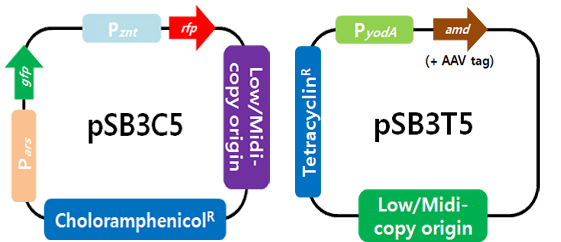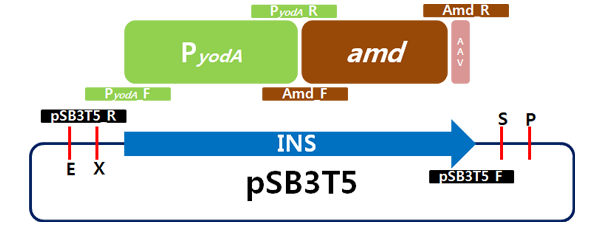Team:KU Seoul/Overview
From 2009.igem.org
(Difference between revisions)
(→Overview) |
|||
| (31 intermediate revisions not shown) | |||
| Line 13: | Line 13: | ||
</head> | </head> | ||
</html> | </html> | ||
| + | {|style= "background:#FFCC33;" align="center" | ||
| + | | | ||
| + | == Overview == | ||
| + | ::'''Integrated Heavy Metal Detection System''' | ||
| + | :::Our team project is designing synthetic modules for simultaneous detection of multiple heavy metals such as | ||
| + | :arsenic, zinc, and cadmium in E. coli. The ultimate goal is to build a micromachine sensing and determining of | ||
| + | :the concentration of heavy metals in a sample solution (e.g. the waste water). In order to design the system, | ||
| + | :we will employ two fluorescence proteins (GFP and RFP) and aryl acylamidase as signal reporters. Since each | ||
| + | :heavy metal promoter produces unique fluorescence or color by those reporters, if more than two heavy metals | ||
| + | :coexist in a solution, the results would be interpreted from the convoluted fluorescence and/or color rather | ||
| + | :than a single signal detection. The successful construction of the synthetic modules in E. coli can be utilized | ||
| + | :in the form of a lyophilized powder, which can be stored in a drug capsule to make it portable. | ||
| + | ::'''STEP1, Prepare plasmids.''' | ||
| + | [[Image:KU_plasmids.png|center]] | ||
| + | :: | ||
| + | :: | ||
| + | :: | ||
| + | :: | ||
| + | :: | ||
| + | ::'''STEP2. Gene cloning & Infusion Biobrick assembly(SLIC)''' | ||
| + | :Using the SLIC method, infuse the biobricks inside of plasmid. There are two inserts just made through SLIC method. | ||
| + | ::::[[Image:insert_yodA_amd.png|center]] | ||
| + | :::: | ||
| + | [[Image:Insert_ars_znt.png|center]] | ||
| + | :: | ||
| + | ::'''STEP3.measuring the concentration of heavy metal''' | ||
| + | |||
| + | ::[[Image:cd2+_detector.png|center]] | ||
| + | :This picture is showing cadimum detection. Another case is similar to this experiments. | ||
| - | |||
| - | |||
| - | |||
| - | |||
| - | |||
| - | |||
| - | |||
| - | |||
| - | |||
| - | |||
| - | |||
| - | |||
| - | |||
| - | |||
| - | |||
| - | |||
| - | |||
| - | |||
| - | |||
| - | |||
| - | |||
| - | |||
| - | |||
| - | |||
| - | |||
| - | |||
| - | |||
| - | |||
| - | |||
| - | |||
| - | |||
| - | |||
| - | |||
|} | |} | ||
Latest revision as of 14:12, 21 October 2009

Overview
|
 "
"






